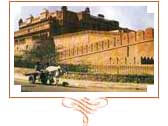Navigation Menu...
-
Reach Us
+91-94142-34143
abhaytravels@gmail.com -
Reach Us
+91-94142-34143
abhaytravels@gmail.com
Bikaner : If you thrill to the inexorable forces of nature, do not miss Bikaner. This is true desert country. You much dismiss any picture post card ideas of the desert, however. There are few sand-dunes here. The Thar Desert is hard rocky soil, solid as brick, it is scrub country, not cactus land, gorse, thorn, milk-weed sprout precariously and the earth is alive with brazen insects and bolder birds. This is camel country. They transport grain, pull heavy carts, work on the wells. Water lies sometimes 122 meters below the surface. Wells are import, almost sacred built on high plaiths with slender minareted towers on each of the four corners, and these wells proclaim their existence from afar, like a shout of welcome.
The approach to Bikaner is bleak. The wonder is that men have chosen to live here or have thought it worth while to risk their lives to win such a kingdom. Rao Jodha Rathore of Marwar retrieved the fortunes of his clan and founded the city of Jodhpur in 1459. He had five sons of whom Bikaji was the most lively and enterprising. Bikaner is situated directly on the ancient caravan routes that come from West/Central Asia. It was therefore a grate centre of trade in the ancient world. This gave rise to a curious phenomenon. The fortified city of Bikaner is encircled by imposing battlement and stands on a slight eminence. Its roads undulate through colorful bazaars and predominant hue of the buildings is the strong reddish pink of local sandstone. Its is the fourth largest city of Rajasthan.

Junagarh Fort : Raja Rai Singh (1571-1611 AD), an outstanding general of Mughal emperor Akbar built this imposing fort. It is encircled by a moat and contains palaces made of red sandstone and marble with kiosks and balconies embellishing the structure at intervals.
Suraj Pol, or the Sun Gate is the main entrance to the fort. Har Mandir is the majestic chapel where the royal weddings and births were celebrated. The palaces worth visiting are Anup Mahal, Karan Mahal, Dungar Niwas, Ganga Niwas and Rang Mahal or Palace of Pleasure. And some of the most beautiful palaces are Chandra Mahal or the Mood Palaces which has exquisite paintings on lime plaster walls; and Phool Mahal or the Flower Palace is more elaborately decorated with inset mirror-work. These places were built by Maharaja Gaj Singh (1746-87). The palaces with in, are adorned with gigantic columns, arches and graceful screens. The façade of the monuments visible above the high invincible walls, offer a splendid view of pavilions protruding out, a row of balconies, kiosks and towers at intervals from a distance.
 Lalgarh Palace : It
was built by Maharaja Ganga Singh to commemorate his father
Maharaja Lal Singh. A spell-binding piece of dextrous carving in
red sandstone marked brilliantly by intricate filigree work.
Lalgarh Palace : It
was built by Maharaja Ganga Singh to commemorate his father
Maharaja Lal Singh. A spell-binding piece of dextrous carving in
red sandstone marked brilliantly by intricate filigree work.
Camel Breeding Farm : This farm, perhaps the only one of its kind in of Asia, is
managed by the Central Government, Bikaner’s Camel Corps (former
Ganga Risala) was a famous fighting force and still maintains
the importance in desert werfare and defence through the Border
Security Force (B.S.F.).
Duration wise | Destination wise
